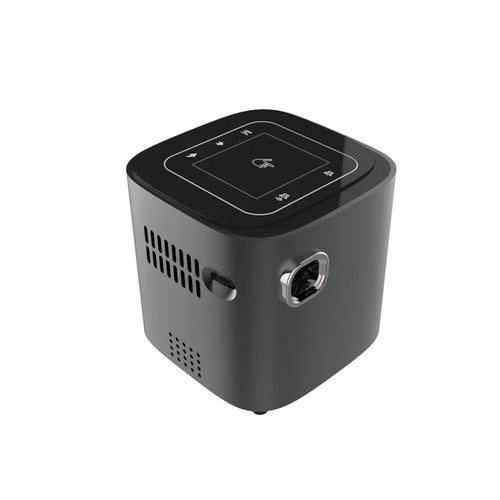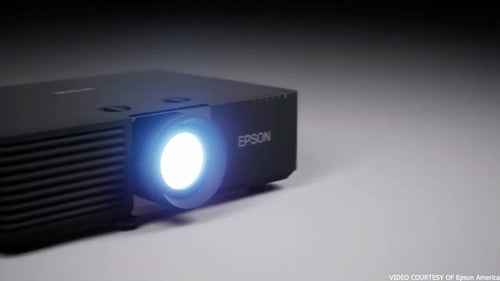From Specs to Screen Size: The Comprehensive Projector Buying Guide

In a world where visuals are pivotal in communication and entertainment, projectors have become indispensable tools. Whether for immersive home theater experiences, dynamic business presentations, or interactive classroom learning, projectors offer a larger-than-life canvas for your content.
However, choosing the right projector involves more than just specs on a sheet. It's about creating an experience that goes beyond pixels and lumens. It's also about understanding how resolution, brightness, and throw distance come together to paint your very own masterpiece on a screen.
In this comprehensive projector buying guide, we'll delve into the world of projectors, from understanding the essential factors to considering screen sizes and ultimately finding the perfect projector to suit your needs.
Factors to Consider Before Buying a Projector
When purchasing a projector, several critical factors shape your decision. Understanding them will enable you to make a well-informed choice that aligns with your intended use and environment.
This projector buying guide includes 13 important considerations for beginners and professionals alike:
1. Usage and Purpose
Clearly define the primary purpose of your projector. Are you planning to use it for creating a captivating home theater experience, delivering impactful business presentations, indulging in immersive gaming, facilitating interactive classroom teaching, or hosting outdoor events?
Different purposes dictate different technical specifications and features. Understanding your intended use allows you to align your choice with the appropriate projector type and capabilities.
2. Resolution
Resolution is the cornerstone of visual clarity. It dictates the number of pixels that make up an image. Common resolutions include HD (1280x720), Full HD (1920x1080), and 4K (3840x2160).
Opting for a higher resolution ensures that images and videos are crisp, detailed, and true to life. However, the optimal resolution depends on the content you plan to display and your budget.
For intricate visual content like movies, documentaries, or high-resolution images, investing in a higher-resolution projector might be worthwhile. Conversely, a standard resolution may suffice for basic presentations or casual use.
3. Brightness
Brightness is measured in lumens and determines how vibrant the projected image appears. Consider the lighting conditions of the area where you intend to use the projector. For a home theater, lower lumens may suffice, while business presentations or outdoor events may require higher lumens to combat ambient light.
4. Contrast Ratio
Another vital factor in this projector buying guide is the contrast ratio. It influences the depth and quality of images by determining the difference between an image's darkest and brightest parts.
Higher contrast ratios result in images with more pronounced shadows and highlights. It also contributes to a more dynamic and detailed image, especially during scenes with diverse lighting conditions.
However, be cautious, as advertised contrast ratios can sometimes be inflated, and real-world performance can vary. Rely on professional reviews and demonstrations for a more accurate assessment.
5. Throw Distance
Throw distance refers to the space between the projector and the screen. It impacts image size and placement, helping you achieve the desired screen size.
Calculate the available space in the room and choose a projector with a throw distance that matches your requirements. Short-throw projectors are ideal for small spaces, while long-throw projectors suit larger environments.
6. Screen Size
Selecting the right screen size is a pivotal decision that profoundly impacts your viewing experience. It's not just about how big the image can get; it's about finding the equilibrium between screen size, viewing distance, and content quality.
- The Viewing Distance. A larger screen demands a more extended throw distance to maintain image quality. Similarly, the viewing distance, or the space between the audience and the screen, must be considered. A balanced ratio between screen size and viewing distance ensures that every seat in the room offers an immersive experience.
- Content Quality. Choosing a massive screen without considering resolution can lead to pixelation and reduced image clarity. Conversely, opting for a small screen with a high-resolution projector might not utilize the projector's full potential. Striking the right balance ensures you enjoy stunning visuals without compromising clarity.
- Room Size and Projection Surface. The physical dimensions of the room also influence screen size selection. A larger room with more seating capacity might require a larger screen to ensure visibility for all viewers. Consider the projection surface, whether it's a wall or a dedicated screen. The screen's reflective properties impact image brightness and overall quality.
7. Connectivity Options
Projectors offer various input ports, such as HDMI, USB, and VGA, to connect to different devices, such as laptops, gaming consoles, Blu-ray players, and audio systems. Ensuring compatibility with your devices is crucial for seamless content sharing.
Additionally, some projectors offer wireless connectivity via Wi-Fi or Bluetooth, allowing for convenient and cable-free content sharing.
8. Keystone Correction and Lens Shift
Keystone correction addresses the distortion when a projector is placed at an angle. This feature ensures that the projected image remains proportionate and visually appealing.
Lens shift, on the other hand, enables vertical and horizontal image adjustments without physically moving the projector. Both features are crucial for achieving a perfectly aligned and distortion-free image, especially in unconventional or challenging installation scenarios.
9. Lamp Life and Maintenance
The projector's lamp life refers to the duration the lamp is expected to last before replacement is needed. Traditional lamps have a finite lifespan, but advancements have led to projectors with longer-lasting lamps or alternative light sources like lasers or LEDs.
Consider not only the lamp's longevity but also the associated replacement costs. Opting for a projector with an extended lamp life or an alternative light source can contribute to long-term cost savings.
10. Sound Quality
While projectors can deliver stunning visuals, their built-in speakers might not provide optimal audio quality. That’s why we included the sound quality in this projector buying guide.
Evaluate the audio capabilities of the projector and decide if additional external speakers or a dedicated audio system is necessary to complement the visual experience. High-quality audio is as essential as the visual component for immersive entertainment or impactful presentations.
11. Additional Features
Beyond the fundamental specifications, projectors have additional features that can enhance your viewing or presentation experience. That’s why we have included the below valuable features in this projector buying guide:
- 3D Capability: Some projectors offer 3D capability, allowing you to enjoy movies, games, and content with a sense of depth and realism. While 3D content availability has evolved over the years if you're a fan of immersive experiences, a projector with 3D functionality might be worth considering.
- Smart Features: Smart projectors are equipped with app compatibility and streaming services, allowing you to access your favorite platforms directly from the projector. This convergence of technology and entertainment makes smart projectors versatile devices for both work and leisure.
- Zoom: The zoom feature, in collaboration with lens shift, enables you to adjust the position and size of the projected image without physically moving the projector. This installation flexibility ensures you achieve the perfect alignment even in challenging spaces.
12. Accessories
Choosing the right projector accessories can enhance your overall viewing or presentation experience. Here are a few essential accessories to consider:
- Screen Selection: Selecting the right projection screen can significantly impact image quality and brightness. Choose a screen that complements your projector's specifications and is suitable for your viewing environment.
- Mounts and Stands: Mounts and stands ensure proper projector placement for optimal image alignment. Ceiling mounts, wall mounts, and adjustable stands offer flexibility in positioning.
- Cables and Adapters: Seamless Connections. Ensure you have the cables and adapters to connect your devices to the projector. HDMI, VGA, and audio cables are commonly used for connectivity.
13. Budget
Budget plays a significant role in determining the projector that suits your needs. While focusing solely on the most expensive options is tempting, finding the projector that offers the best value for your budget is critical.
Here's a breakdown of how budget considerations can guide your decision:
- Establish a Realistic Budget: Set a budget range based on your requirements and priorities. Consider not only the initial cost of the projector but also any additional accessories, cables, and screens that might be necessary.
- Value for Investment: Higher-priced projectors often come with advanced features and better image quality, but that doesn't mean you have to stretch your budget. Identify the crucial features for your intended use and focus on finding a projector that provides the best balance of performance and price.
- Long-Term Considerations: While budget is a significant factor, consider the long-term ownership cost. This includes lamp replacement costs, maintenance expenses, and potential upgrades. A slightly higher upfront investment might save you money in the long run.
Types of Projectors
As you venture deeper into the realm of projectors, you'll encounter various types, each designed to cater to specific needs and contexts. Let's explore the distinct categories of these amazing devices in this projector buying guide.
Home Theater Projectors
Home theater projectors are designed to provide an immersive cinematic experience in your home's comfort. They offer high-resolution imagery, enhanced color accuracy, and superior contrast ratios to replicate the feel of a movie theater.
These projectors are famous for watching movies, TV shows, sports events, and gaming.
Business Projectors
Business projectors are tailored for professional settings and presentations. They emphasize high brightness for well-lit conference rooms, sharp text and graphics display, and easy connectivity for laptops and other devices.
Some models also offer wireless connectivity and interactive features for more engaging presentations.
Portable Projectors
A portable projector is compact and lightweight, making it ideal for on-the-go presentations, outdoor movie nights, and impromptu gatherings. They are usually easy to set up and connect to devices such as laptops, smartphones, and tablets.
Gaming Projectors
Gaming projectors are designed to cater to the needs of avid gamers. They often feature low input lag, high refresh rates, and vivid color reproduction to enhance the gaming experience. Some models also support 3D gaming for an extra layer of immersion.
Short-Throw and Ultra-Short-Throw Projectors
Short-throw and ultra-short-throw projectors are suitable for tight spaces where you can't place the projector far from the screen or wall. Short-throw projectors can produce a large image from a short distance, making them ideal for small rooms or interactive setups.
Interactive Projectors
Interactive projectors allow users to interact directly with the projected content using gestures or digital pens. They are commonly used in education and business settings for presentations, collaboration, and interactive learning.
Pico or Mini Projectors
Pico or mini projectors are incredibly compact and often fit in the palm of your hand. While they sacrifice some image quality and brightness due to their small size, they are great for casual use, personal entertainment, and situations where portability is paramount.
One example of such a projector is the Piqo Mini Projector. This portable projector has a sleek and portable build with impressive features, making it a powerhouse of entertainment. You can enjoy its 1080p HD resolution no matter where you are.
LED/Laser Projectors
These projectors use LED or laser light sources instead of traditional lamps. They have longer lifespans, require less maintenance, and offer improved color accuracy. LED/laser projectors are commonly found in home theater setups and professional environments.
Ensuring Projector’s Maintenance
Ensuring the longevity and optimal performance of your projector requires proper maintenance. Let’s discuss essential considerations in this projector buying guide to keep your projector in prime condition:
- Lamp Life: Projector lamps have a finite lifespan, typically measured in hours. To prolong the lamp's life, use eco-friendly modes, avoid frequent powering on and off, and ensure proper ventilation to prevent overheating.
- Cleaning and Care: Regularly clean the projector's lens, vents, and filters to prevent dust buildup that can degrade image quality and impact ventilation. Follow the manufacturer's guidelines for safe cleaning practices.
- Cooling Systems: Projectors generate heat during operation. Proper ventilation and positioning are crucial to prevent overheating. Ensure that the projector has adequate space around it for appropriate airflow.
Conclusion
The journey from specs to screen size in the world of projectors is a comprehensive one. When buying a projector, knowing essential factors, types of projectors, and maintenance tips will help you make a decision that aligns with your needs.
Remember that the perfect projector isn't just about specifications. Instead, it's about creating memorable experiences that resonate with your audience, whether family, colleagues, or students.







